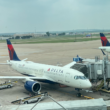Southwest is one of the only airlines that managed to come away relatively unscathed from the IT issues caused by a faulty Crowdstrike update. However, the airline is still finding a way to make headlines. While it is just being reported today, back on July 14th a Southwest Boeing 737-8 MAX came within 150 feet of crashing into the waters of Tampa Bay.

The flight, WN 425, was operating between Columbus John Glenn International Airport (CMH) and Tampa International Airport (TPA). On approach into Tampa during bad weather, the aircraft descended to within 150 feet of the waters of Tampa Bay.
According to flight tracking website FlightRadar24, the aircraft, N8841L, was passing over the Courtney Campbell Causeway as it hit its lowest point.

Southwest 1256, another Boeing 737-8 MAX landed without issue on the same runway just prior to the incident. YouTuber You can see ATC, overlaid the aircraft’s position with the ATC audio in the video below.
As you can hear from the audio, the pilots are remarkably calm and seem to not notice the low altitude issue until it is pointed out to them by air traffic control. The pilots requested to go around and the flight ended up diverting to Fort Lauderdale-Hollywood International Airport (FLL).
We’ve seen a number of issues from Southwest in recent months, including a flight that came within 400 feet of crashing into the ocean off Hawaii. To put this incident into context, this flight had less than half of the distance between the aircraft and the water (150 feet is roughly the height of a 15 story building).
Because of an uptick in issues for both Southwest and Boeing, incidents such as this are likely to grab headlines whenever they occur. While some of the recent incidents have been minor, like wheels falling off of old Boeing aircraft, this flight was a few seconds away from disaster.
Summary
A Southwest Airlines Boeing 737-8 MAX came within 150 feet of crashing into Tampa Bay during an approach to Tampa International Airport (TPA). The aircraft ended up diverting to Fort Lauderdale (FLL) and was not pulled from service, indicating a pilot issue rather than an aircraft issue.






